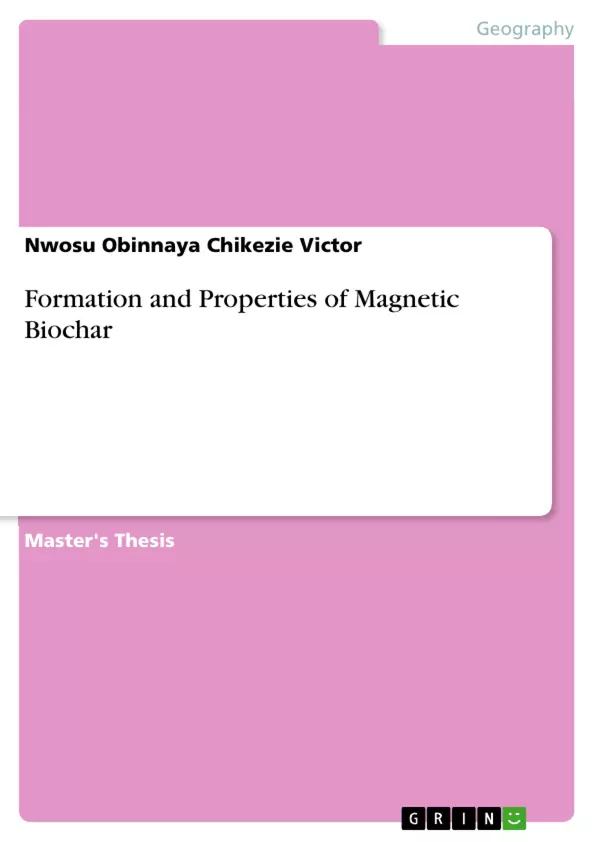Magnetic biochar which is made from agricultural biomass waste such as SRC willow which is a densely planted, increased yielding form of energy crop which is the leading sources in renewable energy production, mixed with iron (II) chloride and iron (III) chloride is known as a multi-dynamic material for land remediation and agricultural uses.
Two magnetic biochars (1,0 M iron solution magnetic biochar and 0,1 M iron solution magnetic biochar) were prepared by the chemical mixture and co-precipitation of iron (II) chloride tetrahydrate and iron (III) chloride on SRC willow with particle size of less than 2mm and the mixture of SRC willow with iron (II) chloride tetrahydrate and iron (III) chloride is dried in the oven and subsequently pyrolysed at a temperature of four hundred degrees celsius which led in iron solution magnetic biochar preparation.
Scanning electron microscopy, Fourier transform infrared spectroscopy and X-ray diffraction analysis were done on the 1.0 M iron solution magnetic biochar and 0.1 M iron solution magnetic biochar depicts a large amount of iron compounds in the 1.0 M iron solution magnetic biochar than in the 0.1 M iron solution magnetic biochar. Ultra-violent infrared spectrometry done on iron (II) chloride tetrahydrate, iron (III) chloride and copper (II) sulphate pentahydrate; atomic absorption spectroscopy and ultra-violent spectrometry was done on copper (II) sulphate pentahydrate and deionised water mixed with 1.0 M iron solution magnetic biochar, 0.1 M iron solution magnetic biochar and activated charcoal nitrot. For copper (II) sulphate pentahydrate solution, 0.1 M iron solution magnetic biochar has a higher adsorption capacity than the 1.0 M iron solution magnetic biochar for Atomic absorption spectroscopy. For ultra-violent infrared spectrometry, the adsorption capacity for 1.0 M iron solution magnetic biochar is higher than the 0.1 M iron solution magnetic biochar.
Inhaltsverzeichnis (Table of Contents)
- CHAPTER ONE
- General introduction
- Literature
- Background
- Explanation of Biochar
- Explanation of Biochar Production
- Current and Potential future uses of Biochar
- Explanation of Magnetic Biochar
- Project aim and objectives
- CHAPTER TWO
- Methodology
- Experimental Procedure
- Sample Characterisation
- Adsorption Experiment
- CHAPTER THREE
- Results and discussion
- Characterisation of Samples
- Adsorption analysis of 40ppm of copper (II) sulphate pentahydrate With 1.0 M iron solution magnetic biochar
- Adsorption analysis of 60ppm of Copper (II) sulphate pentahydrate with 1.0 M, 0.1 M Iron solution magnetic biochar and Activated charcoal nitrot
- Adsorption analysis of 3.0ppm of Copper (II) sulphate pentahydrate with 1.0 M, 0.1 M Iron solution magnetic biochar and Activated nitrot
- CHAPTER FOUR
- Conclusion and Suggestions for Further Work
- Conclusion
- Suggestions for Further Work
- REFERENCES
Zielsetzung und Themenschwerpunkte (Objectives and Key Themes)
This thesis aims to explore the formation and properties of magnetic biochar, specifically its application as a potential adsorbent for the removal of heavy metals from aqueous solutions. The study focuses on the development of a novel magnetic biochar material and its characterization through various experimental techniques.
- Formation and characterization of magnetic biochar.
- Evaluation of magnetic biochar's effectiveness as an adsorbent for heavy metals.
- Comparison of magnetic biochar's performance to traditional adsorbents like activated charcoal.
- Exploration of the influence of iron concentration on the adsorption process.
- Potential environmental applications and future directions for magnetic biochar research.
Zusammenfassung der Kapitel (Chapter Summaries)
Chapter One provides a comprehensive introduction to biochar, its production methods, current and potential future uses, and a detailed explanation of magnetic biochar. This chapter also outlines the project's specific aims and objectives.
Chapter Two delves into the methodology employed in the research. It details the experimental procedures, including sample preparation, characterization techniques, and the adsorption experiments conducted. The chapter also outlines the specific procedures used for characterizing samples and conducting adsorption analyses.
Chapter Three presents the results obtained from the research, focusing on the characterization of the magnetic biochar samples and the adsorption analysis of copper (II) sulphate pentahydrate. The chapter analyzes the data obtained from various adsorption experiments, exploring the influence of different iron concentrations on the adsorption process.
Schlüsselwörter (Keywords)
The main keywords and focus topics of this thesis include biochar, magnetic biochar, adsorption, heavy metals, copper (II) sulphate pentahydrate, environmental remediation, and sustainable technologies.
- Citation du texte
- Nwosu Obinnaya Chikezie Victor (Auteur), 2011, Formation and Properties of Magnetic Biochar, Munich, GRIN Verlag, https://www.grin.com/document/1253724



